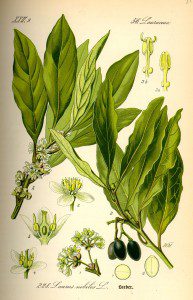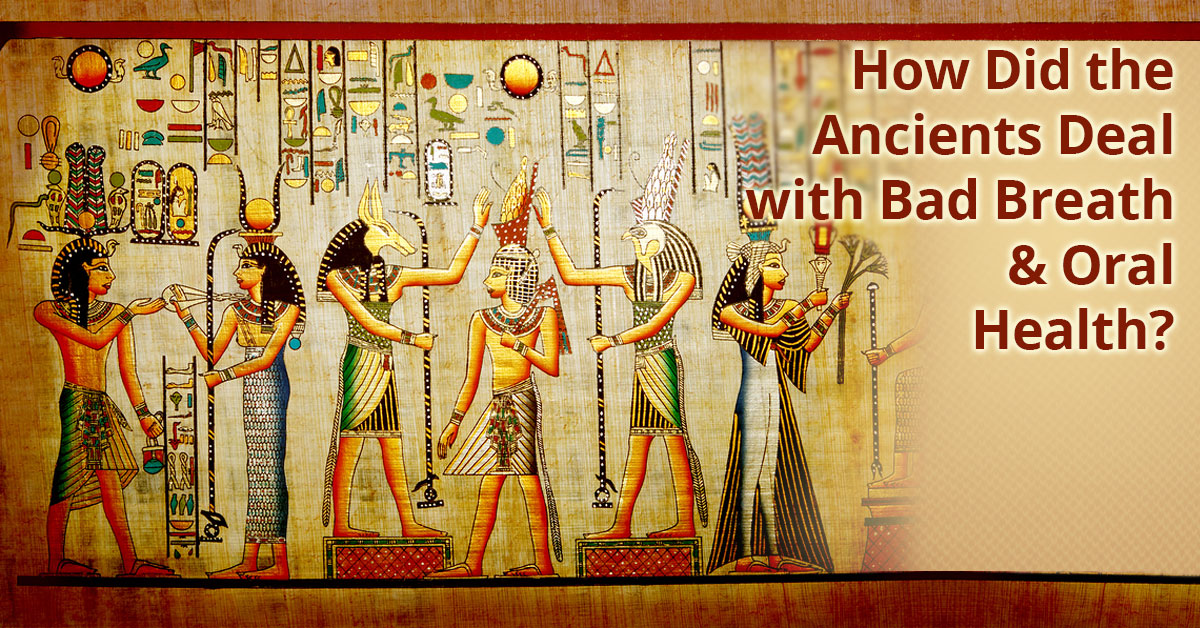The next time you are in the drugstore and glance at the multitudinous choices you have before you for toothpastes, toothbrushes and mouthwashes, think for a moment – how did our ancestors deal with nasty breath, oral decay and gum disease?
Dentistry as we know it has strong roots (ha, no pun intended) in ancient Greece and Egypt, and the cleaning of the tongue was a critical part of Indian medicine!
In ancient Greece, for example, cleaning teeth was generally accomplished with one’s finger. Either the finger was wrapped with a cotton cloth, and then rubbed over the teeth to clean them, or the finger was dipped in some powdered substance with special properties to clean the teeth. These tooth powders were the forerunners of our modern toothpaste.

Laurus nobilis, commonly known as the Laurel, used by ancients for oral hygiene
Sometimes, the branch of a tree whose fragrant essential oils had antiseptic and other therapeutic properties for the teeth and gums could be chewed. The chewed end would then come to resemble a brush of sorts, whose loose, frayed fibers could be brushed over the teeth to clean them.
One tree native to Greece and much used by the ancient Greeks that fits these requirements rather nicely is the Laurel. Known for its use as crowns for victors in athletic competitions, the Laurel’s essential oils are antiseptic, and also stimulate blood circulation to the gums, promoting their health and regeneration. After chewing on the branch, or the leaves, your mouth is cleaned, and left with a fresh, clean scent.
And, the ancient Greeks were concerned about bad breath too!
Sometimes fresh, fragrant green herbs were chewed after a meal to cleanse the teeth and mouth and freshen the breath. These fresh herbs included those of Fennel and Parsley. To this day, fresh Parsley is often chewed to remove the odor of Garlic. The seeds of these and other plants, such as the Cardamom, were also chewed to cleanse the mouth and freshen the breath.
What About Tongue Cleaning?
The recommendation to include the tongue in the daily hygiene routine is not as well documented as other dental practices, but we know that tongue cleaning devices have been used since ancient times in India and China.
In Ayurveda, the practice of traditional Indian medicine, daily tongue cleaning is recommended in order to remove toxic debris known as Ama and, to this day, tongue cleaning devices are a common drug store item in Indian and Pakistani drugstores. AND, tongue cleaning became a chic practice in 19th century Europe, with devices made from sterling silver, ivory and tortoise shell!
And herein lies the problem. Ancient tongue scrapers have been found in archaeological digs on multiple continents. The technology behind tongue scrapers has literally not changed for hundreds of years. Why would you let your friends and loved ones use a centuries-old tongue scraper when the right tool for the job is here?! If they aren’t convinced, send ’em over to check out why the TUNG Brush is so much better than tongue scrapers.
So the next time you use TUNG Brush and GEL as part of your daily oral hygiene routine, just think of how important tongue cleaning has been throughout history! And don’t forget… we’re now offering free shipping on 4-packs of our products. A great way to get started is with the TUNG Partner Pack, which includes a TUNG Brush for you and for your significant other, and a TUNG Gel for each of you as well!
Photo Credits:
Andreyuu via BigStock
Prof. Dr. Otto Wilhelm Thomé Flora von Deutschland, Österreich und der Schweiz 1885, Gera, Germany, Public Domain, via Topjabot


